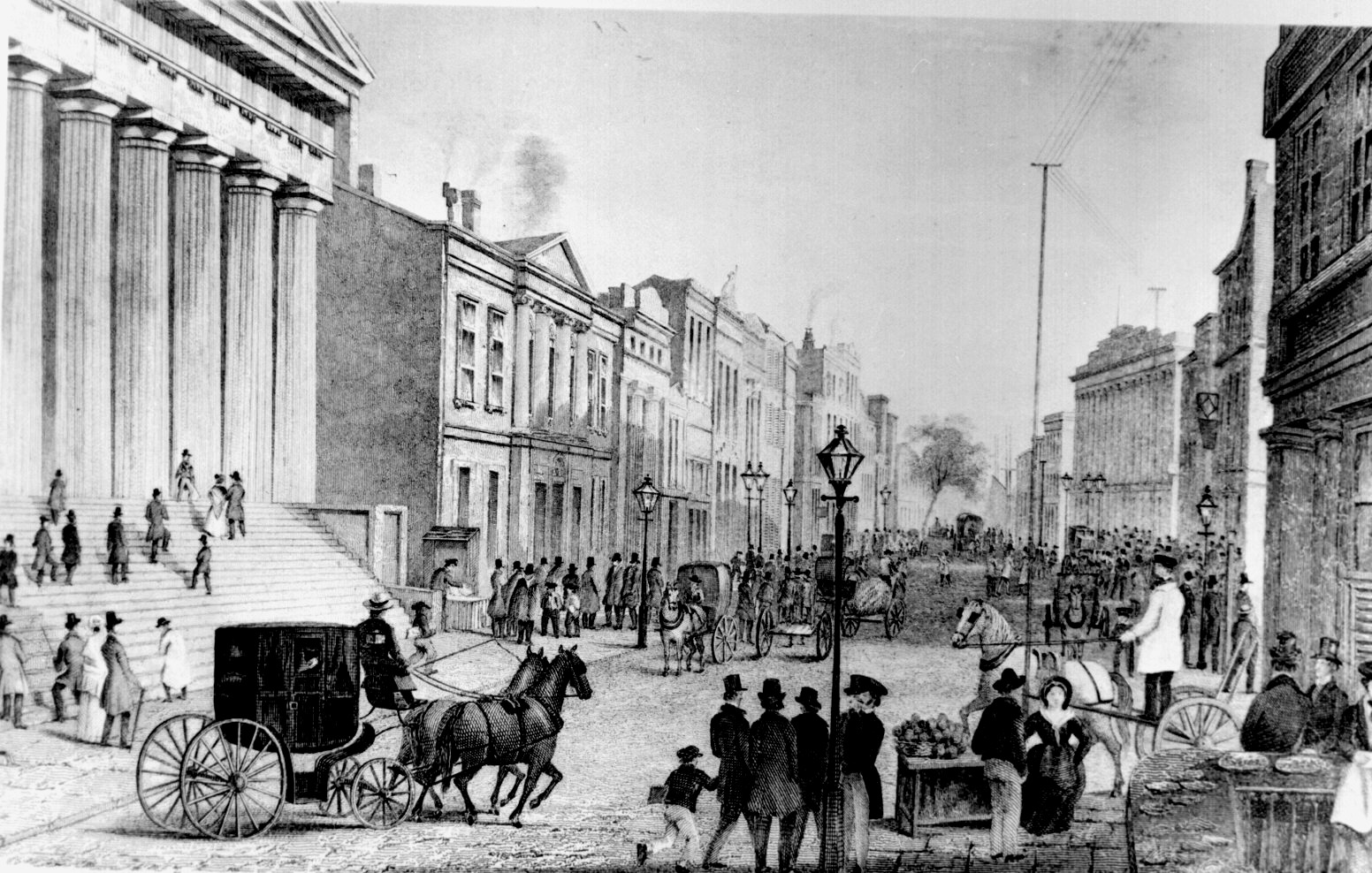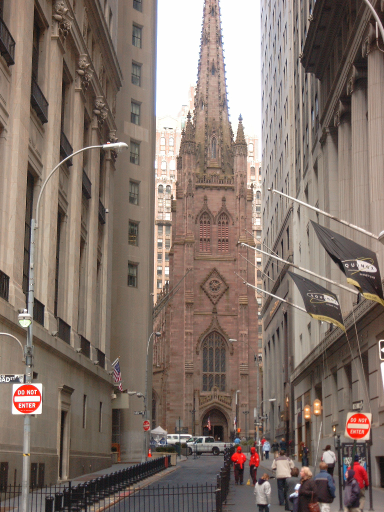Wall Street
| |
|
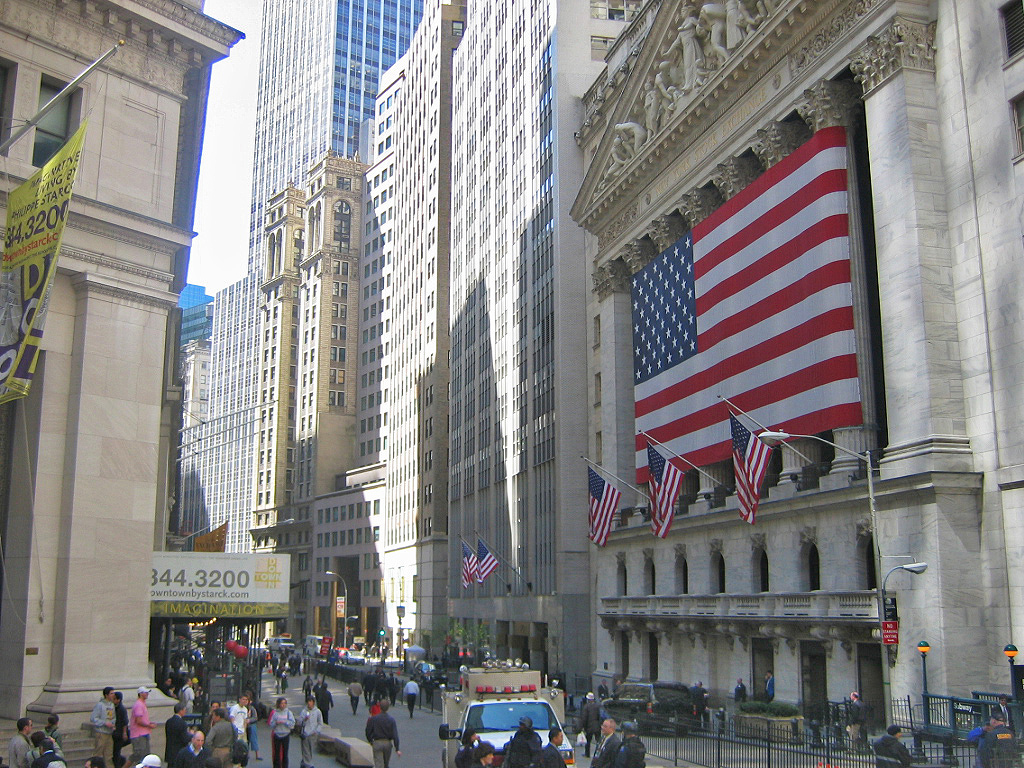 Wall Street é uma rua em Manhattan, Nova Yorque, nos EUA. Esta rua extende-se da Broadway à South Street em East River, passando pelo centro histórico do distrito financeiro. A Wall Street foi a primeira sede permanente da New York Stock Exchange; ao longo do tempo Wall Street passou também a ser o nome do bairro circundante. Também ao longo do tempo, Wall Street tornou-se um sinónimo para a indústria financeira Americana.
Wall Street é uma rua em Manhattan, Nova Yorque, nos EUA. Esta rua extende-se da Broadway à South Street em East River, passando pelo centro histórico do distrito financeiro. A Wall Street foi a primeira sede permanente da New York Stock Exchange; ao longo do tempo Wall Street passou também a ser o nome do bairro circundante. Também ao longo do tempo, Wall Street tornou-se um sinónimo para a indústria financeira Americana.
Índice
História
O nome da rua deriva do facto de que durante o século XVII, Wall Street constituía a fronteira norte de Nova Amsterdam. Nessa altura (1640s), cercas básicas delimitavam propriedades e residências na colónia. Mais tarde, Peter Stuyvesant, parcialmente usando escravos Africanos, construiu uma barreira, ou muro, mais sofisticado, usando madeira e terra. Este muro foi criado, e melhorado ao longo do tempo, para servir como defesa contra ataques de variadas tribos de nativos Americanos, colonos e Britânicos. Em 1685, Wall Street foi estabelecida ao longo deste muro. O muro foi desmantelado pelos Britânicos em 1699.
No final do século XVIII, existia uma árvore, um Plátano, no final da Wall Street, debaixo da qual os traders e especuladores se juntavam para transaccionar informalmente entre si. Em 1792, os traders formalizaram a sua associação com o Acordo de Buttonwood. Esta seria a origem da New York Stock Exchange.
In 1789, Federal Hall and Wall Street was the scene of the United States' first presidential inauguration. George Washington took the oath of office on the balcony of Federal Hall overlooking Wall Street on April 30, 1789. This was also the location of the passing of the Bill Of Rights
In 1889, the original stock report, Customers' Afternoon Letter, became the The Wall Street Journal, named in reference to the actual street, it is now an influential international daily business newspaper published in New York City.<ref>DOW JONES HISTORY - THE LATE 1800s 2006 Dow Jones & Company, Inc. Retrieved 19 August 2006.</ref> For many years, it had the widest circulation of any newspaper in the United States, although it is currently second to USA Today.<ref>Fulford, Robert (2002-04-20). The Wall Street Journal redesigns itself. Consultado a 2006-08-19.</ref> It has been owned by Rupert Murdoch's News Corp. since 2007.
Decline and revitalization
Predefinição:For The Manhattan Financial District is one of the largest business districts in the United States, and second in New York City only to Midtown. In the late 19th and early 20th centuries, the corporate culture of New York was a primary center for the construction of skyscrapers (rivaled only by Chicago). The Financial District, even today, actually makes up a distinct skyline of its own, separate from but not soaring to quite the same heights as its midtown counterpart a few miles to the north.
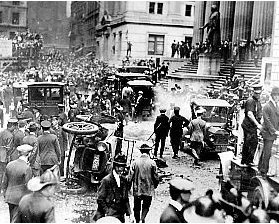 Built in 1914, 23 Wall Street was known as the "House of Morgan" and for decades the bank's headquarters was the most important address in American finance. At noon, on September 16, 1920, a bomb exploded in front of the bank, killing 38 and injuring 300. Shortly before the bomb went off a warning note was placed in a mailbox at the corner of Cedar Street and Broadway. While theories abound about who was behind the Wall Street bombing and why they did it, after twenty years investigating the matter, the FBI rendered the file inactive in 1940 without ever finding the perpetrators.
Built in 1914, 23 Wall Street was known as the "House of Morgan" and for decades the bank's headquarters was the most important address in American finance. At noon, on September 16, 1920, a bomb exploded in front of the bank, killing 38 and injuring 300. Shortly before the bomb went off a warning note was placed in a mailbox at the corner of Cedar Street and Broadway. While theories abound about who was behind the Wall Street bombing and why they did it, after twenty years investigating the matter, the FBI rendered the file inactive in 1940 without ever finding the perpetrators.
 1929 brought the "Great Crash" of the stock market, ushering in the Great Depression. During this era, new development of the Financial District had stagnated. The construction of the World Trade Center was one of the few major projects undertaken during the last three quarters of the 20th century and, financially, it was not originally as successful as planned. Some point to the fact that it was actually a government-funded project, constructed by the Port Authority of New York and New Jersey with the intention of spurring economic development in downtown. All the tools necessary to international trade were to be housed in the complex. However, at the beginning much of the space remained vacant.
1929 brought the "Great Crash" of the stock market, ushering in the Great Depression. During this era, new development of the Financial District had stagnated. The construction of the World Trade Center was one of the few major projects undertaken during the last three quarters of the 20th century and, financially, it was not originally as successful as planned. Some point to the fact that it was actually a government-funded project, constructed by the Port Authority of New York and New Jersey with the intention of spurring economic development in downtown. All the tools necessary to international trade were to be housed in the complex. However, at the beginning much of the space remained vacant.
Nonetheless, some large and powerful firms did purchase space in the World Trade Center. Further, it attracted other powerful businesses to the immediate neighborhood. In some ways, it could be argued that the World Trade Center changed the nexus of the Financial District from Wall Street to the Trade Center complex. When the World Trade Center was destroyed in the September 11, 2001 attacks, it left somewhat of an architectural void as new developments since the 1970s had played off the complex aesthetically. The attacks, however, contributed to the loss of business on Wall Street, due to temporary-to-permanent relocation to New Jersey and further decentralization with establishments transferred to cities like Chicago and Boston.
Wall Street itself and the Financial District as a whole are crowded with highrises by any measure. Further, the loss of the World Trade Center has actually spurred development in the Financial District on a scale that hadn't been seen in decades. This is in part due to tax incentives provided by the federal, state and local governments to encourage development. A new World Trade Center complex, centered on Daniel Liebeskind's Memory Foundations plan, is in the early stages of development and one building has already been replaced. The centerpiece to this plan is the Predefinição:Convert tall Freedom Tower. New residential buildings are already sprouting up, and buildings that were previously office space are being converted to residential units, also benefiting from the tax incentives. Better access to the Financial District is planned in the form of a new commuter rail station and a new downtown transportation center centered on Fulton Street.
Wall Street's culture is often criticized as being rigid. This is a decades-old stereotype stemming from the Wall Street's establishment's protection of their interests, and the link to the WASP establishment. More recent criticism has centered on structural problems and lack of a desire to change well-established habits. Wall Street's establishment resists government oversight and regulation. At the same time, New York City has a reputation as a very bureaucratic city, which makes entry into the neighborhood difficult or even impossible for middle class entrepreneurs.
Since the founding of the Federal Reserve banking system, the Federal Reserve Bank of New York in the Financial District has been the point where monetary policy in the United States is implemented (although it is decided in Washington, D.C. by the Federal Reserve Bank's Board of Governors). As such, New York State is today unique in that it is the only state that constitutes its own district of the Federal Reserve Banking system. This is perhaps partly owed to population distribution in the United States of the time, however. Until the 1960s, New York was the most populated state in the U.S.; it now ranks third, behind California and Texas. The NY Federal Reserve's president is the only regional Bank president with a permanent vote and is traditionally selected as its vice chairman. The bank has a gold vault 80 feet (25 m) beneath the street. This depository is the largest in the world, larger even than Fort Knox.
Buildings
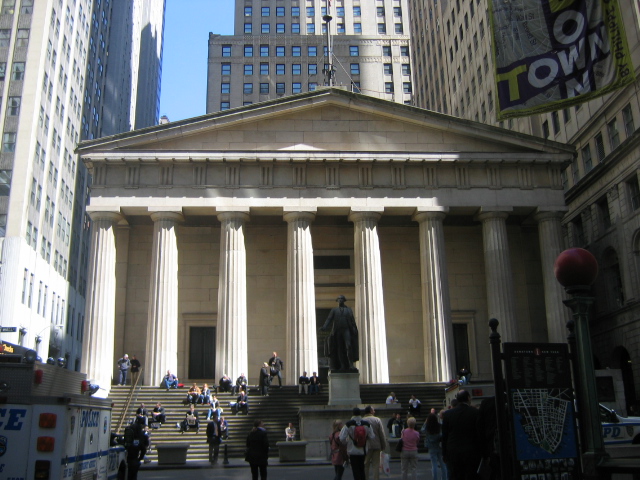 Wall Street's architecture is generally rooted in the Gilded Age, though there are also some art deco influences in the neighborhood. Landmark buildings on Wall Street include Federal Hall, 14 Wall Street (Bankers Trust Company Building), 40 Wall Street (The Trump Building), and the New York Stock Exchange at the corner of Broad Street.
Wall Street's architecture is generally rooted in the Gilded Age, though there are also some art deco influences in the neighborhood. Landmark buildings on Wall Street include Federal Hall, 14 Wall Street (Bankers Trust Company Building), 40 Wall Street (The Trump Building), and the New York Stock Exchange at the corner of Broad Street.
Personalities
Over the years, certain elite persons associated with Wall Street have become famous. Although their reputations are usually limited to members of the stock brokerage and banking communities, several have gained national and international fame. Some earned their fame for their investment strategies, financing, reporting, legal or regulatory skills, while others are remembered for their greed. One of the most iconic representations of the market prosperity is the Charging Bull sculpture, by Arturo Di Modica. Representing the bull market economy, the sculpture was originally placed in front of the New York Stock Exchange, and subsequently moved to its current location in Bowling Green.
Cultural influence
Wall Street vs. Main Street
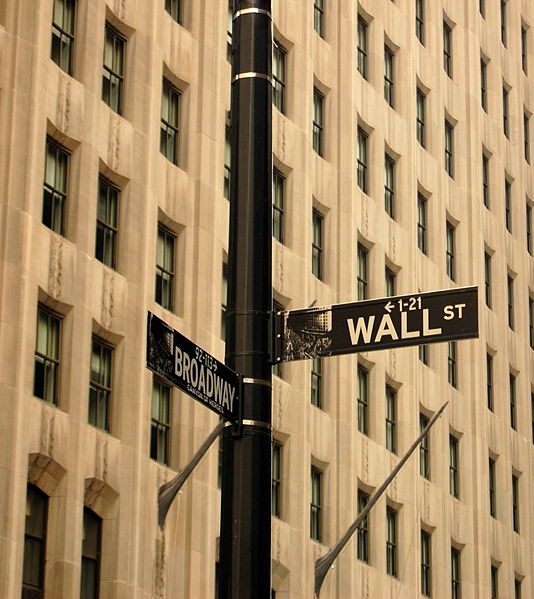
Perceptions
The older skyscrapers often were built with elaborate facades; such elaborate aesthetics haven't been common in corporate architecture for decades. The World Trade Center, built in the 1970s, was very plain and utilitarian in comparison (the Twin Towers were often criticized as looking like two big boxes, despite their impressive height).
Wall Street, more than anything, represents financial and economic power. To Americans, Wall Street can sometimes represent elitism and power politics and cut-throat capitalism, but it also stirs feelings of pride about the market economy. Wall Street became the symbol of a country and economic system that many Americans see as having developed not through colonialism and plunder, but through trade, capitalism, and innovation.<ref>Fraser (2005).</ref>
In popular culture
- Herman Melville's classic short story Bartleby the Scrivener is subtitled A Story of Wall Street and provides an excellent portrayal of a kind and wealthy lawyer's struggle to reason with that which is unreasonable as he is pushed beyond his comfort zone to "feel" something real for humanity.
- In William Faulkner's novel The Sound and the Fury, Jason Compson hits on other perceptions of Wall Street: after finding some of his stocks are doing poorly, he blames the Jews.
- On January 26, 2000, the band Rage Against The Machine filmed the music video for "Sleep Now in the Fire" on Wall Street, which was directed by Michael Moore. The band at one point stormed the Stock Exchange, causing the doors of the Exchange to be closed early (2:52 P.M.). Trading on the Exchange floor, however, continued uninterrupted.<ref>Basham, David (2000-01-28). Rage Against The Machine Shoots New Video With Michael Moore. MTV News. Consultado a 2007-09-24.</ref><ref>NYSE special closings since 1885 (PDF). Consultado a 2007-09-24.</ref>
- The film Wall Street exemplifies many popular conceptions of Wall Street, being a tale of shady corporate dealings and insider trading.<ref>IMDb entry for Wall Street Retrieved 19 August 2006.</ref>
- In the film National Treasure a clue to finding the Templar Treasure leads the main characters to Wall Street's Trinity Church.
- TNA Wrestler Robert Roode is billed from "Wall Street in Manhattan, New York".
Transportation
Pier 11 Because Wall Street was historically a commuter destination, it has seen much transportation infrastructure developed with it in mind. Today, Pier 11 at the foot of the street is a busy ferry terminal, and the New York City subway has three stations under Wall Street itself:
- Wall Street (IRT Broadway-Seventh Avenue Line) at Wall Street & William Street
- Wall Street (IRT Lexington Avenue Line) at Wall Street & Broadway
- Broad Street (BMT Nassau Street Line) at Wall Street & Broad Street
Financial districts worldwide
Wall street is most closely rivaled by the City of London (London's "Square Mile", also known as "The City", the original city at the heart of Greater London) and Canary Wharf. Other notable financial districts around the world include:
- Amsterdam's Damrak
- Tokyo's Marunouchi
- Singapore's Shenton Way at Raffles Place,
- Chicago's Chicago Loop,
- San Francisco's Financial District
- Boston's Financial District, Boston, Massachusetts
- Hong Kong's Central,
- Shanghai's Lujiazui in Pudong,
- Paris's La Défense,
- Frankfurt's Bankenviertel,
- Toronto's Bay Street,
- Seoul's Teheranno,
- Athens's Sofokleous Street,
- Mumbai's Dalal Street,
- Dhaka's Motijheel,
- Sydney's Martin Place,
- Karachi's Ibrahim Ismail Chundrigar Road,
- Sao Paulo's Paulista Avenue,
- Mexico City's Paseo de la Reforma,
- Zurich's Paradeplatz.
See also
Notes
References
- Atwood, Albert W. and Erickson, Erling A. "Morgan, John Pierpont, (Apr. 17, 1837 - Mar. 31, 1913)," in Dictionary of American Biography, Volume 7 (1934)
- Carosso, Vincent P. The Morgans: Private International Bankers, 1854-1913. Harvard U. Press, 1987. 888 pp. ISBN 978-0674587298
- Carosso, Vincent P. Investment Banking in America: A History Harvard University Press (1970)
- Chernow, Ron. The House of Morgan: An American Banking Dynasty and the Rise of Modern Finance, (2001) ISBN 0-8021-3829-2
- Fraser, Steve. Every Man a Speculator: A History of Wall Street in American Life HarperCollins (2005)
- Geisst; Charles R. Wall Street: A History from Its Beginnings to the Fall of Enron. Oxford University Press. 2004. online edition
- John Moody; The Masters of Capital: A Chronicle of Wall Street Yale University Press, (1921) online edition
- Morris, Charles R. The Tycoons: How Andrew Carnegie, John D. Rockefeller, Jay Gould, and J. P. Morgan Invented the American Supereconomy (2005) ISBN 978-0805081343
- Perkins, Edwin J. Wall Street to Main Street: Charles Merrill and Middle-class Investors (1999)
- Robert Sobel The Big Board: A History of the New York Stock Market (1962)
- Robert Sobel The Great Bull Market: Wall Street in the 1920s (1968)
- Robert Sobel Inside Wall Street: Continuity & Change in the Financial District (1977)
- Strouse, Jean. Morgan: American Financier. Random House, 1999. 796 pp. ISBN 978-0679462750
External links
Predefinição:Streets of Manhattan Predefinição:United States topics
